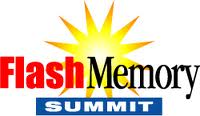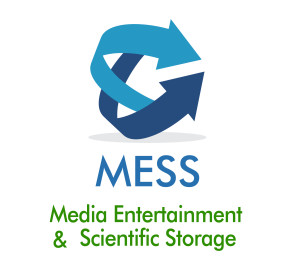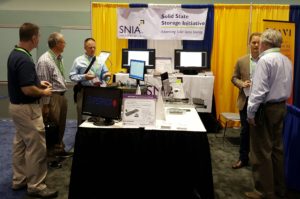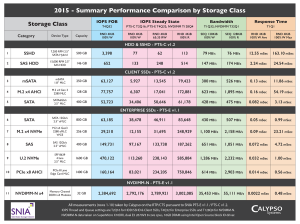SSSI returns to the Flash Memory Summit in booth 808, featuring information on updates on new tests in the SNIA Solid State Storage Performance Test Specification-Enterprise 1.1, NVM programming, and Workload I/O Capture Program (WIOCP) activities; new tech notes and white papers, including a PTS User Guide Tech Note, a PCIe SSD 101 Whitepaper, and a Performance Primer Whitepaper; and PCIe SSD demonstrations from SSSI members Bitmicro, Fastor, and Micron.
 All current SSSI members attending FMS and individuals from companies interested in the SSSI and their activities are cordially invited to the SSSI Solid State Storage Reception Monday evening August 12 from 5:30 pm – 7:00 pm in Room 209-210 at the Santa Clara Convention Center. At the reception, SSSI Education Chair Tom Coughlin of Coughlin Associates will provide an overview of the SSD market, and SSSI Chair Paul Wassenberg of Marvell will discuss SSD performance. SSSI Vice Chair Walt Hubis of Fusion-io will discuss SSSI programs, including PTS, NVM Programming, Workload I/O Capture, and PCIe SSD. Refreshments, table displays, and an opportunity drawing for SSDs provided by SSSI members Intel, Micron, and OCZ will be featured.
All current SSSI members attending FMS and individuals from companies interested in the SSSI and their activities are cordially invited to the SSSI Solid State Storage Reception Monday evening August 12 from 5:30 pm – 7:00 pm in Room 209-210 at the Santa Clara Convention Center. At the reception, SSSI Education Chair Tom Coughlin of Coughlin Associates will provide an overview of the SSD market, and SSSI Chair Paul Wassenberg of Marvell will discuss SSD performance. SSSI Vice Chair Walt Hubis of Fusion-io will discuss SSSI programs, including PTS, NVM Programming, Workload I/O Capture, and PCIe SSD. Refreshments, table displays, and an opportunity drawing for SSDs provided by SSSI members Intel, Micron, and OCZ will be featured.
FMS conference activities begin August 13, and the agenda can be found here. SSSI members speaking and chairing panels include:
Tuesday August 13
4:35 pm – Paul Wassenberg of Marvell on Standards
Wednesday August 14
8:30 am – Eden Kim and Easen Ho of Calypso Testers – PCIe Power Budgets, Performance, and Deployment
9:50 am – Eden Kim and Easen Ho of Calypso Testers – SNIA Solid State Storage Performance Test Specification
3:10 pm – Walt Hubis of Fusion-io – Revolutionizing Application Development Using NVM Storage Software
3:10 pm – Easen Ho of Calypso Testers – SSD Testing Challenges
4:30 pm – Paul von Behren of Intel – SNIA Tutorial: SNIA NVM Programming Model: Optimizing Software for Flash
Thursday August 15
3:10 pm – Jim Pappas of Intel – PCI Express and Enterprise SSDs
3:10 pm – Jim Handy of Objective Analysis – Market Research
An open “Chat with the Experts” roundtable session Tuesday August 13 at 7:00 pm will feature Jim Pappas of Intel at a Standards table, Eden Kim of Calypso Testers at a SSD Performance table, Easen Ho of Calypso Testers at a Testing table, and Paul Wassenberg of Marvell at a SATA Express table.
The Media Entertainment and Scientific Storage (MESS) will hold their August “Meetup” at the Open Chat with the Experts, and also be located in SSSI Booth 808 for further discussions.
Exhibit admission is complimentary until August 8. SNIA and SSSI members and colleagues can receive a $100 discount on either the 3-day conference or the 1-day technical program using the code SNIA at www.flashmemorysummit.com.
 http://www.flashmemorysummit.com
http://www.flashmemorysummit.com


